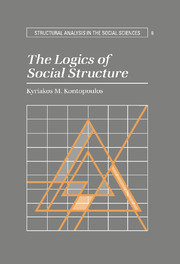Book contents
- Frontmatter
- Contents
- Preface
- Introduction
- Part I Metatheoretical considerations
- Part II Compositionist logics
- 5 Methodological individualism
- 6 Constructionism/compositionism: elementary notions
- 7 Complex systems of interaction
- Part III Logics of hierarchy
- Part IV Heteracrchical logics
- Part V The phenomenology of social structures
- Appendix: The logics of structuration
- Glossary
- Bibliography
- Index
7 - Complex systems of interaction
Published online by Cambridge University Press: 24 October 2009
- Frontmatter
- Contents
- Preface
- Introduction
- Part I Metatheoretical considerations
- Part II Compositionist logics
- 5 Methodological individualism
- 6 Constructionism/compositionism: elementary notions
- 7 Complex systems of interaction
- Part III Logics of hierarchy
- Part IV Heteracrchical logics
- Part V The phenomenology of social structures
- Appendix: The logics of structuration
- Glossary
- Bibliography
- Index
Summary
The micrologics we have discussed in the previous chapter are, in many respects, still quite simple, notwithstanding their relatively different degrees of complexity. On the other hand, the compositionist/constru-tionist logic must be able to demonstrate the emergence or construction of more and more complex, higher-level systems of structured interaction. Or, to wear our critical-evaluative hat, it is here that we find a telling weakness of most of the compositionist programs – their basic inability to spell out systematically the transition, translation, or aggregation rules or mechanisms leading to these more complex systems. It will be helpful to review some examples from the relevant microsociological literature.
The first example comes from structural balance theory and its extensions and modifications in the course of the formal study of clique and group formation (for a summation see Leik and Meeker 1975). The initial formalization of Heider's structural balance theory demonstrated that, if the possible relations in a pair of interactants were hypothesized to be two (like and agree; dislike and disagree), then, with the insertion of a third person into the relationship, eight possible triads were derived, of which only four were considered balanced (Heider 1958). In the further modifications of the theory's assumptions sixteen such triads were formally derived, of which eight or nine were considered balanced. Now imagine the results of the movement from three-person to many-person relations! We will be obliged to come to terms with unlimited open possibilities.
- Type
- Chapter
- Information
- The Logics of Social Structure , pp. 126 - 150Publisher: Cambridge University PressPrint publication year: 1993



